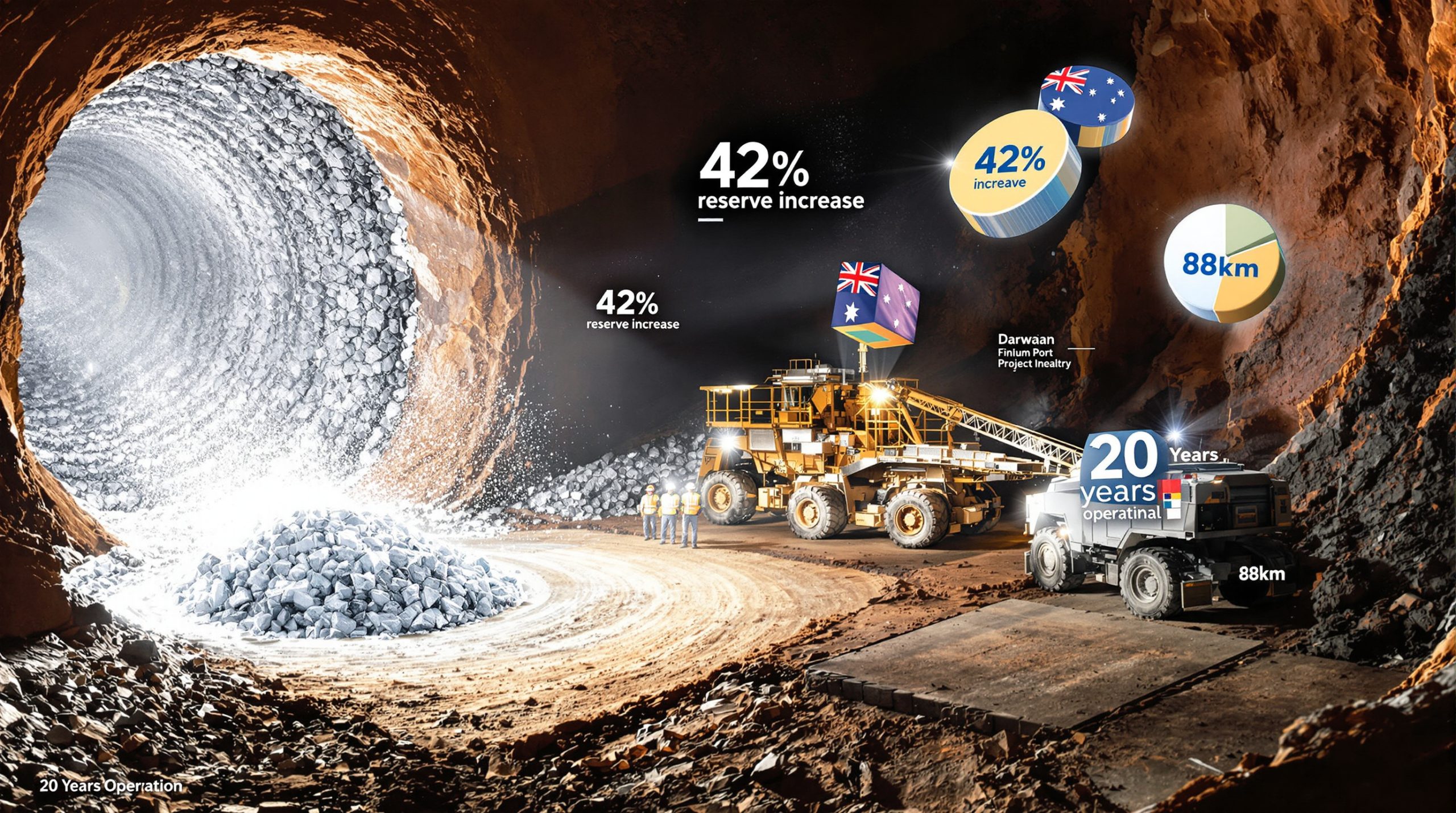What Makes Litchfield Minerals' Copper Sulphide Discovery a Game-Changer?
The recent Litchfield Minerals copper sulphide discovery at their Oonagalabi project represents a potentially transformative development in Australia's critical minerals landscape. With exceptional width, near-surface mineralization, and promising grade indicators, this discovery comes at a pivotal time for the global copper market.
Unpacking the Remarkable 104m Copper Hit at Oonagalabi
Litchfield Minerals (ASX:LMS) has announced an extraordinary copper sulphide intersection that has captured significant market attention. The 104-meter wide copper mineralization starts directly from surface at the company's Oonagalabi project, located approximately 125km northeast of Alice Springs in Australia's Northern Territory.
Preliminary Portable X-Ray Fluorescence (PXRF) readings indicate grades of approximately 1.37% copper equivalent, including a significant zinc component of 1.6%. Multiple high-grade zones are scattered throughout the intersection length, with abundant visible chalcopyrite (a copper-iron sulphide mineral) reported throughout the samples.
"Hole 10 is a positive milestone for proving this system hosts grades as well as volume," noted Matthew Pustahya, Managing Director of Litchfield Minerals, in the company's announcement. "Over 100m of copper sulphide mineralisation, with multiple high-grade zones, is an outstanding outcome. Every hole to date has hit copper mineralisation, reinforcing the strength and continuity of this system."
The discovery's significance is magnified by its surface expression, as mineralization beginning at ground level substantially reduces potential future mining costs by eliminating overburden removal requirements—a major economic advantage compared to deeper deposits that require extensive pre-stripping or underground development.
How Does This Discovery Compare to Other Copper Finds?
Notable Features Setting This Discovery Apart
The Litchfield Minerals copper sulphide discovery stands out for several key reasons that differentiate it from typical copper exploration results:
- Exceptional Width: The 104-meter intersection width suggests potential for bulk mining approaches that can deliver economies of scale
- Surface Expression: Mineralization beginning at surface significantly reduces potential mining costs
- Consistent Mineralization: Every drill hole completed to date has encountered copper mineralization
- Grade Profile: The 1.37% copper equivalent grade compares favorably with many operating copper mines globally
- Polymetallic Credits: The additional 1.6% zinc content enhances the overall economic potential
While many recent copper discoveries globally occur at significant depths requiring expensive underground mining methods, the Oonagalabi intersection's surface expression potentially simplifies extraction economics considerably.
Regional Significance in the Northern Territory
The discovery holds particular importance for the Northern Territory, which remains relatively underexplored compared to Western Australia and other established mining jurisdictions. Success at Oonagalabi could trigger renewed mineral exploration insights interest in this frontier region, potentially establishing a new copper mining district.
The Northern Territory government has been actively promoting mineral exploration through various initiatives, recognizing the economic development opportunities that significant discoveries like this one can bring to remote regions.
What Technical Indicators Support the Discovery's Importance?
The Role of VTEM in Targeting Success
The technical pathway to this discovery highlights the effectiveness of modern exploration methods when systematically applied. Litchfield employed Versatile Time Domain Electromagnetic (VTEM) surveys to identify multiple priority conductors at Oonagalabi. This geophysical technique is particularly effective at detecting sulphide-hosted mineralization at depth.
The company's exploration strategy combined this advanced geophysics with traditional field techniques including surface mapping and ground truthing to validate geophysical targets before drilling. This methodical approach led to the strategic placement of drill holes above major VTEM survey sulphide targets, with Hole 10 producing the breakthrough result.
Importantly, the company has reported that multiple untested conductors remain within the project area, suggesting significant additional discovery potential beyond this initial intersection.
From PXRF to Laboratory Assays: What to Expect
While the preliminary PXRF readings have generated considerable excitement, it's important to understand the limitations of this technology. Portable XRF provides rapid preliminary grade estimates but requires confirmation through laboratory analysis.
Significantly, Litchfield has indicated that "our experience from previous fieldwork campaigns is that the assays are regularly returned with higher grades than the field pXRF results." This historical correlation at the project suggests the possibility that laboratory results, expected within approximately one month, could potentially exceed the already promising field readings.
Industry experts note that PXRF technology has limitations including surface-only readings and potential matrix interference, making laboratory assays the definitive standard for resource assessment and economic evaluation.
What Happens Next at Oonagalabi?
Immediate Exploration Priorities
The pathway from discovery to potential development involves several crucial next steps:
-
Laboratory Assays: Full laboratory analysis to confirm the preliminary PXRF results, expected within approximately one month
-
Follow-up Drilling: Additional drilling to determine the extent and continuity of mineralization both along strike and at depth
-
Metallurgical Testing: Initial metallurgical work to assess recovery rates and processing requirements for the copper-zinc mineralization
-
Geophysical Refinement: Further geophysical surveys to refine additional drill targets based on the successful VTEM targeting methodology
-
Resource Modeling: Preliminary resource modeling to begin understanding the potential scale of the discovery
These activities will likely occupy the next 12-24 months as Litchfield works to define the resource potential at Oonagalabi.
Pathway to Resource Definition
The timeline from discovery to potential development typically spans several years, with key milestones including:
- Exploration and Resource Definition: 12-24 months to establish the resource parameters
- Preliminary Economic Assessment: 6-12 months following initial resource definition
- Environmental and Social Studies: Beginning early and continuing throughout the development pathway
- Detailed Feasibility Studies: 12-24 months to establish definitive project economics
- Permitting and Approvals: Running concurrently with feasibility work
- Potential Development Decision: Typically 3-5 years from discovery for projects with favorable economics
How Has the Market Responded to This Discovery?
Share Price Movement Analysis
The market response to Litchfield's discovery announcement has been dramatic. The company's share price surged approximately 240% following the news, closing at 62 cents per share. This exceptional performance made Litchfield the top ASX gainer on the announcement day, with trading volume surging substantially above average.
This market reaction occurred despite broader weakness related to renewed tariff concerns impacting the wider ASX, underscoring the significance investors have attached to this discovery.
The company's market capitalization expanded to approximately $26 million following the announcement, though this remains modest compared to the potential value of a significant copper resource, suggesting continued rerating potential as further results emerge.
What Investors Are Watching For
Key catalysts that investors will monitor include:
- Laboratory Assay Results: Confirmation and potential enhancement of the preliminary PXRF grades
- Follow-up Drill Results: Demonstration of mineralization continuity and potential resource scale
- Resource Definition Timeline: Clarity on the pathway to maiden resource estimation
- Corporate Development: Potential strategic partnerships or investment interest from larger mining companies
How Does This Discovery Fit into the Global Copper Landscape?
Copper Market Fundamentals
This discovery comes at a critical time for global copper markets. Industry analysts project a growing supply deficit through 2030 as electrification and renewable energy adoption accelerates worldwide. Copper plays an essential role in these technologies, with electric vehicles requiring approximately four times more copper than conventional vehicles.
The copper market has experienced limited major discoveries in recent years, with declining ore grades at many existing operations further constraining global copper supply forecast. New projects often face extended development timelines due to permitting complexities, environmental considerations, and capital intensity.
Against this backdrop, a near-surface, potentially bulk-mineable discovery with favorable grades represents a valuable potential contribution to future supply in a market expected to face structural deficits. Furthermore, as surging copper demand continues, discoveries of this nature take on strategic importance.
Australia's Position in Critical Minerals Supply
Australia has identified critical minerals, including copper, as strategic priorities within its resources sector. Government initiatives supporting critical minerals exploration and development have increased in recent years, recognizing both economic opportunities and supply chain security considerations.
The Northern Territory government in particular has worked to streamline permitting processes for strategic resources while maintaining appropriate environmental and social safeguards. Indigenous engagement forms a central part of this approach, with opportunities for community development through resource projects.
What Are the Technical Challenges Ahead?
From Discovery to Development: Key Considerations
While the initial discovery appears promising, several technical challenges must be addressed on the pathway to potential development:
-
Metallurgical Characterization: Detailed test work will be required to establish optimal processing methods and recovery rates for both copper and zinc, particularly given the sulphide-dominant mineralization
-
Water Access and Management: The Northern Territory's arid conditions present water supply challenges that must be carefully addressed in project planning
-
Power Supply Infrastructure: Remote locations typically require either grid extension or self-generation solutions, adding to capital requirements
-
Environmental Considerations: Baseline studies, impact assessments, and management plans will be essential components of any development pathway
-
Social License: Engagement with local communities, particularly indigenous stakeholders, represents a critical success factor
Resource Expansion Potential
The discovery's open-ended nature presents significant opportunities for resource growth beyond the initial intersection. Key expansion pathways include:
- Strike Extensions: Testing the continuation of mineralization along geological strike
- Depth Potential: Evaluating mineralization persistence below current drilling depths
- Parallel Structures: Investigating additional mineralized zones identified by geophysics
- Regional Targets: Exploring similar geological settings within the broader project area
FAQ: Understanding Copper Exploration Results
What does "copper equivalent" mean in this context?
Copper equivalent (CuEq) represents the combined economic value of copper and other metals (in this case, zinc) expressed as a single copper grade percentage. The calculation considers the relative prices and expected recovery rates of each metal. The 1.37% CuEq reported by Litchfield includes both the copper content and the economic contribution of 1.6% zinc.
How reliable are PXRF readings compared to laboratory assays?
PXRF provides preliminary indications but has limitations in accuracy and depth of measurement. Laboratory assays remain the industry standard and will provide definitive grade information. At Oonagalabi, historical correlation suggests laboratory results may exceed PXRF readings, adding to the discovery's potential significance.
What is chalcopyrite and why is its presence significant?
Chalcopyrite (CuFeS₂) is the most common copper-bearing mineral in economic deposits worldwide. Its visible presence throughout samples provides strong evidence of primary copper mineralization and suggests potential for conventional processing methods. The mineral typically responds well to standard flotation concentration techniques used in copper processing.
Why are zinc credits important in copper deposits?
Zinc credits can significantly enhance project economics by providing additional revenue streams from the same mining operation. The 1.6% zinc content reported at Oonagalabi represents potentially valuable co-product mineralization that could improve overall project economics through the production of a separate zinc concentrate.
Conclusion: A Significant Addition to Australia's Critical Minerals Landscape
The Litchfield Minerals copper sulphide discovery at Oonagalabi represents one of the more promising copper exploration results announced on the ASX in recent years. While still at an early stage requiring substantial additional work to determine economic viability, the combination of width, grade, polymetallic credits, and surface expression creates a compelling exploration case.
As global copper demand continues to accelerate through electrification trends and renewable energy transition, discoveries of this nature take on additional strategic importance. For investors, the company's relatively modest market capitalization even after the share price surge suggests potential for continued revaluation as the resource is further defined. The discovery also aligns with broader copper price insights pointing to strong long-term fundamentals.
The discovery also reinforces the Northern Territory's emergence as a frontier for critical minerals exploration, potentially establishing a new mining district with associated economic development opportunities for the region. With multiple untested targets remaining, the copper investment perspectives for the project appear particularly intriguing.
Disclaimer: The information presented in this article is based on preliminary exploration results that require confirmation through additional work. Investing in early-stage mineral exploration companies involves substantial risks including the potential for partial or complete loss of capital. Readers should conduct their own research and seek professional financial advice before making investment decisions.
Want to Spot the Next Major Copper Discovery Before the Market?
Discovery Alert's proprietary Discovery IQ model instantly notifies investors about significant mineral discoveries like Litchfield's Oonagalabi copper find, giving you a crucial market advantage. Explore how historic discoveries have generated exceptional returns by visiting our discoveries page and start your free 30-day trial today.




